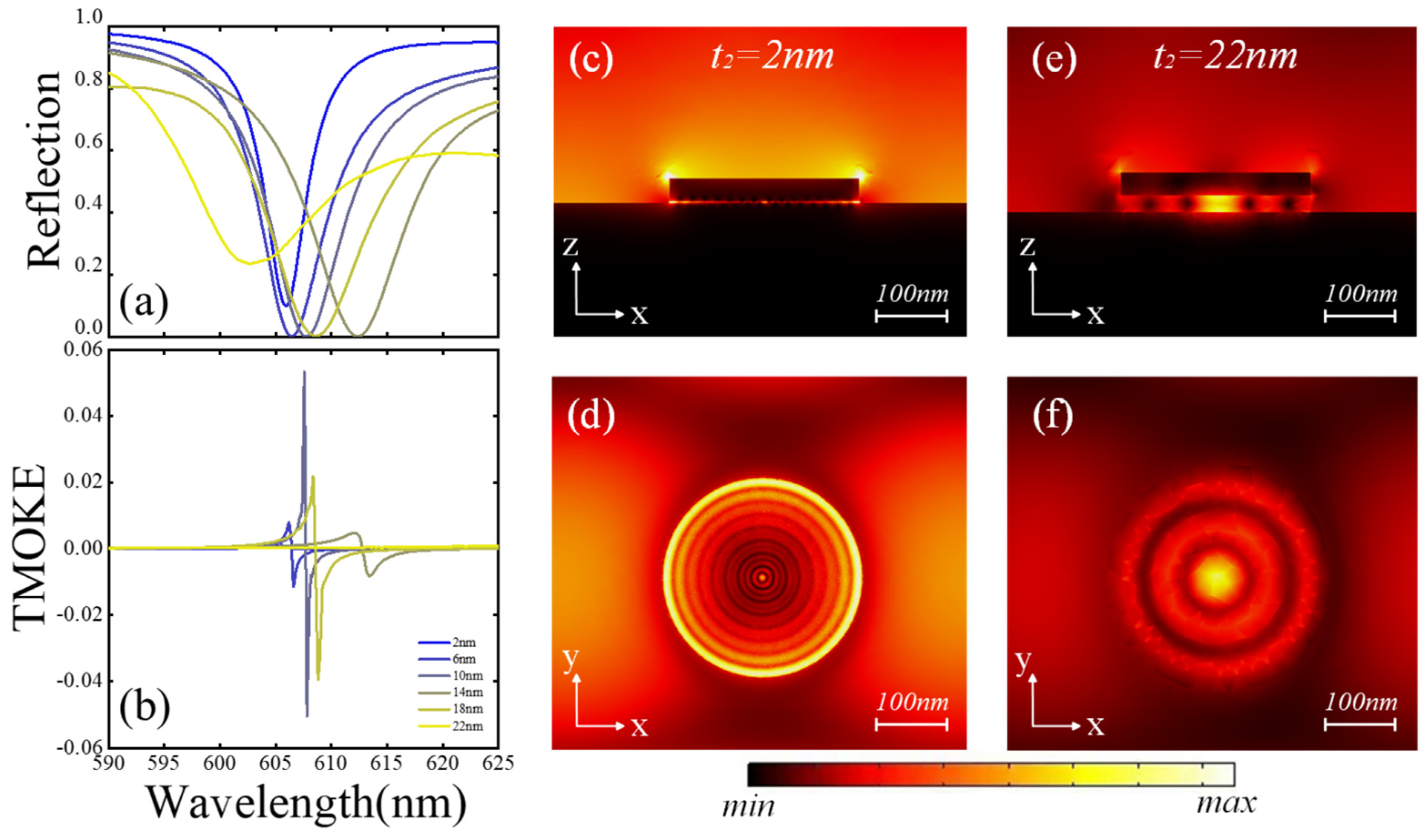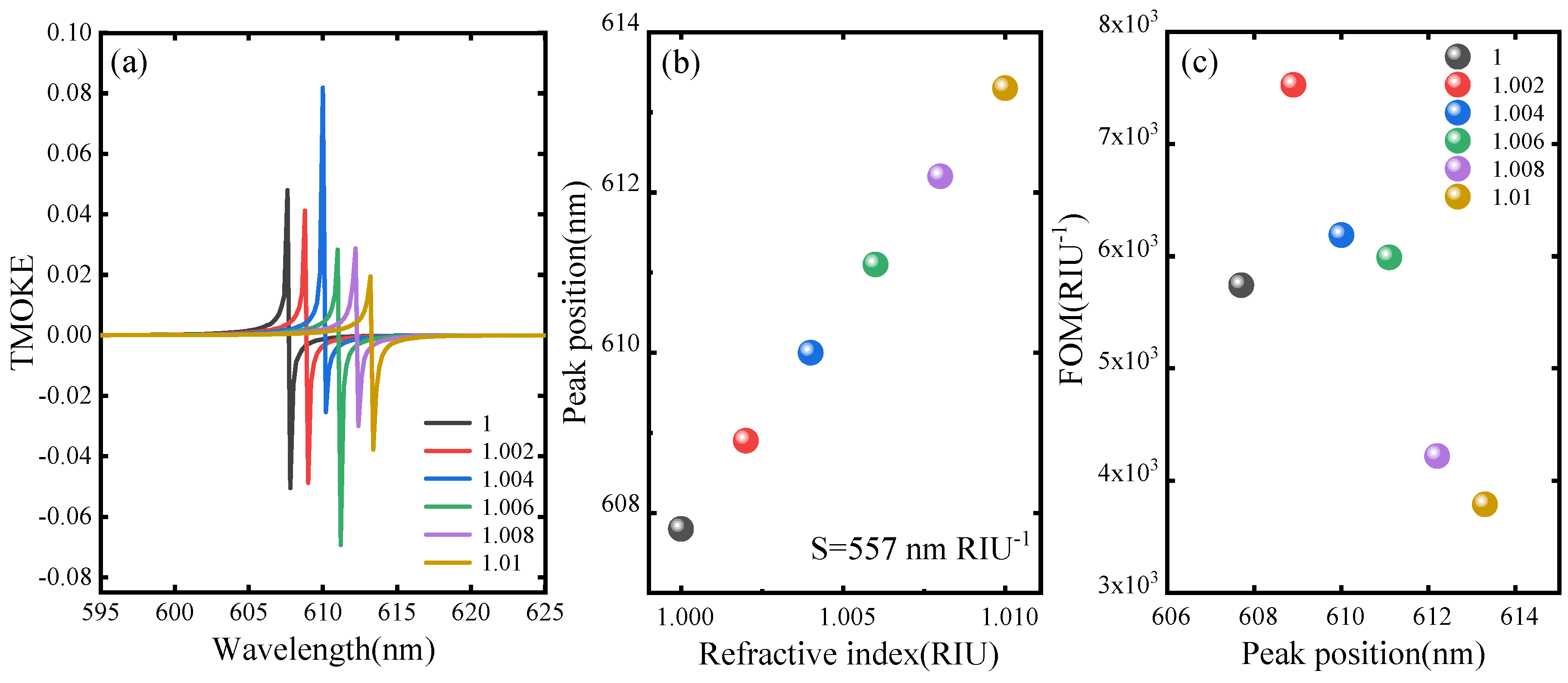Magnetoplasmonic Resonators Designed with Hexagonally Arrayed Au/BIG Bilayer Nanodisks on Au Thin Film Layers for Enhanced MOKE and Refractive Index Sensing
Abstract
1. Introduction
2. Theoretical Analysis
3. Results and Discussion
4. Conclusions
Supplementary Materials
Author Contributions
Funding
Institutional Review Board Statement
Informed Consent Statement
Data Availability Statement
Conflicts of Interest
References
- Krinchik, G.S.; Artem’Ev, V.A. Magneto-optical Properties of Ni, Co, and Fe in the Ultraviolet Visible and Infrared Parts of the Spectrum. J. Exp. Theor. Phys. 1968, 6, 1080–1085. [Google Scholar]
- Temnov, V.V. Ultrafast acousto-magneto-plasmonics. Nat. Photon 2012, 6, 728–736. [Google Scholar] [CrossRef]
- Caballero, B.; Garci, A.; Cuevas, J.C. Hybrid Magnetoplasmonic Crystals Boost the Performance of Nanohole Arrays as Plasmonic Sensors. ACS Photonics 2016, 3, 203–208. [Google Scholar] [CrossRef]
- Li, L.; Zong, X.; Liu, Y. All-metallic metasurfaces towards high-performance magneto-plasmonic sensing devices. Photonics Res. 2020, 8, 1742–1748. [Google Scholar] [CrossRef]
- Lou, P.; Wu, Q.; Zhang, C.; Wang, Z.; Song, Y. Enhanced magneto-optical Kerr effect via the synergistic effect of surface plasmon resonance and spin–orbit coupling in Au@Pt nanohybrid layers. J. Phys. D Appl. Phys. 2023, 56, 375001. [Google Scholar] [CrossRef]
- Belotelov, V.I.; Akimov, I.A.; Pohl, M.; Kotov, V.A.; Kasture, S.; Vengurlekar, A.S.; Gopal, A.V.; Yakovlev, D.R.; Zvezdin, A.K.; Bayer, M. Enhanced magneto-optical effects in magnetoplasmonic crystals. Nat. Nanotechnol. 2011, 6, 370–376. [Google Scholar] [CrossRef] [PubMed]
- Zhang, C.; Cui, X.; Zhang, W.; Zhu, R.; Song, Y. Numerical design of surface magneto-plasmon sensors of Au/Co double-layer square arrayed nanopores on the continuous gold thin film. J. Appl. Phys. 2023, 134, 024301. [Google Scholar] [CrossRef]
- Li, L.; Du, L.; Zong, X.; Liu, Y. VIS-NIR TMOKE enhanced dielectric-metal hybrid structure for high performance dual-channel sensing. Opt. Express 2023, 31, 35880–35891. [Google Scholar] [CrossRef]
- Chai, H.; Lu, Y.; Zhang, W. Enhancement of transverse magneto-optical Kerr effects and high sensing performance in a trilayer structure with nanopore arrays. Results Phys. 2021, 31, 105049. [Google Scholar] [CrossRef]
- Miroshnichenko, A.E.; Flach, S.; Kivshar, Y.S. Fano resonances in nanoscale structures. Rev. Mod. Phys. 2009, 82, 2257–2298. [Google Scholar] [CrossRef]
- Regatos, D.; Sepúlveda, B.; Fariña, D.; Carrascosa, L.G.; Lechuga, L.M. Suitable combination of noble/ferromagnetic metal multilayers for enhanced magneto-plasmonic biosensing. Opt. Express 2011, 19, 8336–8346. [Google Scholar] [CrossRef] [PubMed]
- Moncada-Villa, E.; Oliveira, O.N.; Mejía-Salazar, J.R. ε-Near-Zero Materials for Highly Miniaturizable Magnetoplasmonic Sensing Devices. J. Phys. Chem. C 2019, 123, 3790–3794. [Google Scholar] [CrossRef]
- Manera, M.; Rella, R. Improved gas sensing performances in SPR sensors by transducers activation. Sens. Actuators B Chem. 2013, 179, 175–186. [Google Scholar] [CrossRef]
- Okuda, T.; Koshizuka, N.; Hayashi, K.; Taniguchi, H.; Yamamoto, H. Synthesis of New Magnetooptical Material, Bismuth Iron Garnet. IEEE Transl. J. Magn. Jpn. 1988, 3, 483–484. [Google Scholar] [CrossRef]
- Popova, L.M.H.N.E. Magnetic properties of the magnetophotonic crystal based on bismuth iron garnet. Appl. Phys. 2012, 112, 093910. [Google Scholar] [CrossRef]
- WLi, K.; Guo, G.-Y. First-principles study on magneto-optical effects in the ferromagnetic semiconductors Y3Fe5O12 and Bi3Fe5O12. Phys. Rev. B 2021, 103, 014439. [Google Scholar]
- Li, D.; Tang, Z.; Chen, L.; Lei, C.; Zhang, S.; Tang, S.; Du, Y. Plasmonics Resonance Enhance Magneto-Optical Effects Through Metallic Sub-wavelength Grating with Bismuth Iron Garnet Slab. Plasmonics 2018, 13, 55–62. [Google Scholar] [CrossRef]
- Ferreiro-Vila, E.; González-Díaz, J.B.; Fermento, R.; González, M.U.; García-Martín, A.; García-Martín, J.M.; Cebollada, A.; Armelles, G.; Meneses-Rodríguez, D.; Sandoval, E.M. Intertwined magneto-optical and plasmonic effects in Ag/Co/Ag layered structures. Phys. Rev. B Condens. Matter Mater. Phys. 2009, 80, 125132. [Google Scholar] [CrossRef]
- Maccaferri, N.; Inchausti, X.; García-Martín, A.; Cuevas, J.C.; Tripathy, D.; Adeyeye, A.O.; Vavassori, P. Resonant Enhancement of Magneto-Optical Activity Induced by Surface Plasmon Polariton Modes Coupling in 2D Magnetoplasmonic Crystals. ACS Photonics 2015, 2, 1769–1779. [Google Scholar] [CrossRef]
- Ordal, M.A.; Long, L.L.; Bell, R.J.; Bell, S.E.; Bell, R.R.; Alexander, R.W., Jr.; Ward, C.A. Optical properties of the metals Al, Co, Cu, Au, Fe, Pb, Ni, Pd, Pt, Ag, Ti, and W in the infrared and far infrared. Appl. Opt. 1983, 22, 1099–1119. [Google Scholar] [CrossRef]
- Chang, C.-Y.; Lin, H.-T.; Lai, M.-S.; Shieh, T.-Y.; Peng, C.-C.; Shih, M.-H.; Tung, Y.-C. Flexible Localized Surface Plasmon Resonance Sensor with Metal–Insulator–Metal Nanodisks on PDMS Substrate. Sci. Rep. 2018, 8, 11812. [Google Scholar] [CrossRef] [PubMed]
- Kekatpure, R.D.; Hryciw, A.C.; Barnard, E.S.; Brongersma, M.L. Solving dielectric and plasmonic waveguide dispersion relations on a pocket calculator. Opt. Express 2009, 17, 24112–24129. [Google Scholar] [CrossRef] [PubMed]
- BDiaz-Valencia, F.; Mejía-Salazar, R.; Oliveira, O.N., Jr.; Porras-Montenegro, N.; Albella, P. Enhanced transverse magneto-optical Kerr effect in magnetoplasmonic crystals for the design of highly sensitive plasmonic (bio)sensing Platforms. ACS Omega 2017, 2, 7682. [Google Scholar] [CrossRef] [PubMed]
- Li, L.; Zong, X.; Liu, Y. Tunable magneto-optical responses in magneto-plasmonic crystals for refractive index sensing. J. Phys. D Appl. Phys. 2020, 53, 185106. [Google Scholar] [CrossRef]
- González-Díaz, J.B.; García-Martín, A.; Armelles, G.; Navas, D.; Vázquez, M.; Nielsch, K.; Wehrspohn, R.B.; Gösele, U. Enhanced Magneto-Optics and Size Effects in Ferromagnetic Nanowire Arrays. Adv. Mater. 2007, 19, 2643–2647. [Google Scholar] [CrossRef]
- Khartsev, S.I.; Grishin, A.M. High performance [Bi3Fe5O12/Sm3Ga5O12]m magneto-optical photonic crystals. J. Appl. Phys. 2007, 101, 053906. [Google Scholar] [CrossRef]
- Mikhailova, T.V.; Berzhansky, V.N.; Shaposhnikov, A.N.; Karavainikov, A.V.; Prokopov, A.R.; Kharchenko, Y.M.; Lukienko, I.M.; Miloslavskaya, O.V.; Kharchenko, M.F. Optimization of one-dimensional photonic crystals with double layer magneto-active defect. Opt. Mater. 2018, 78, 521–530. [Google Scholar] [CrossRef]




| Sructures | FOM (RIU−1) |
|---|---|
| Au/Co/Au film with periodic subwavelength hole arrays [3] | 2500 |
| Au/Co bilayer nanodisk array on the optical thick metal film [4] | 6000 |
| Au grating on a metal magneto-optical layer [23] | 3000 |
| Au nanowire array on top of a cobalt film [24] | 1852 |
| This work | 7527 |
Disclaimer/Publisher’s Note: The statements, opinions and data contained in all publications are solely those of the individual author(s) and contributor(s) and not of MDPI and/or the editor(s). MDPI and/or the editor(s) disclaim responsibility for any injury to people or property resulting from any ideas, methods, instructions or products referred to in the content. |
© 2025 by the authors. Licensee MDPI, Basel, Switzerland. This article is an open access article distributed under the terms and conditions of the Creative Commons Attribution (CC BY) license (https://creativecommons.org/licenses/by/4.0/).
Share and Cite
Wang, Z.; Cui, X.; Song, Y. Magnetoplasmonic Resonators Designed with Hexagonally Arrayed Au/BIG Bilayer Nanodisks on Au Thin Film Layers for Enhanced MOKE and Refractive Index Sensing. Coatings 2025, 15, 601. https://doi.org/10.3390/coatings15050601
Wang Z, Cui X, Song Y. Magnetoplasmonic Resonators Designed with Hexagonally Arrayed Au/BIG Bilayer Nanodisks on Au Thin Film Layers for Enhanced MOKE and Refractive Index Sensing. Coatings. 2025; 15(5):601. https://doi.org/10.3390/coatings15050601
Chicago/Turabian StyleWang, Ziqi, Xiaojian Cui, and Yujun Song. 2025. "Magnetoplasmonic Resonators Designed with Hexagonally Arrayed Au/BIG Bilayer Nanodisks on Au Thin Film Layers for Enhanced MOKE and Refractive Index Sensing" Coatings 15, no. 5: 601. https://doi.org/10.3390/coatings15050601
APA StyleWang, Z., Cui, X., & Song, Y. (2025). Magnetoplasmonic Resonators Designed with Hexagonally Arrayed Au/BIG Bilayer Nanodisks on Au Thin Film Layers for Enhanced MOKE and Refractive Index Sensing. Coatings, 15(5), 601. https://doi.org/10.3390/coatings15050601







